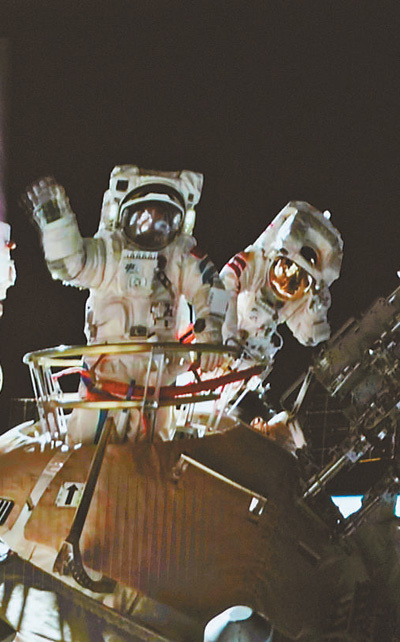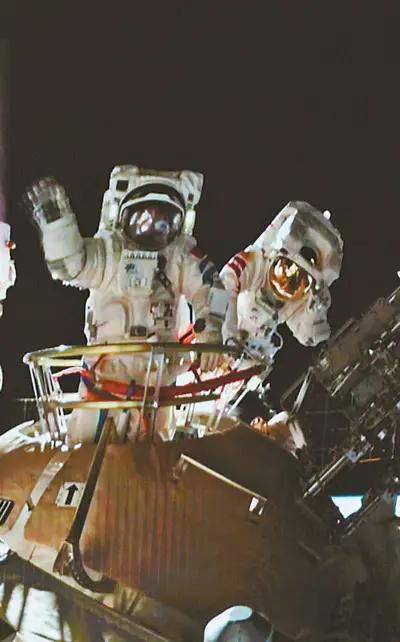By Liu Shiyao, Yu Jianbin, People’s Daily

Chinese astronauts Nie Haisheng and Liu Boming, both crew members of China’s Shenzhou-12 spaceflight mission, wave to the Earth after completing an extravehicular activity, August 20, 2021. (Photo/Website of China Manned Space)
The three astronauts of China’s Shenzhou-12 crewed mission met the press on the afternoon of Dec. 7, making their first public appearance since their return to the Earth three months earlier.
At the press conference held by the China Astronaut Research and Training Center in Beijing, the three astronauts, i.e. Nie Haisheng, Liu Boming and Tang Hongbo, were in good shape and full of energy.
Jing haipeng, head of the Astronaut Corps of the Chinese People’s Liberation Army, introduced the crew members’ recovery from their 90-day stay in space and their follow-up plans at the press conference.
According to Jing, recovery of the crew members following their return to Earth includes three stages, specifically quarantine, recuperation and observation. So far, they have already completed the first two stages.
The three astronauts are emotionally stable and in good psychological condition. Their weight is at the same level as that before the space flight, and their muscle strength, endurance, as well as motor and cardiopulmonary functions have been further restored and met expectations.
Jing said the three astronauts have entered the observation stage and will resume their regular training after completing health assessment.
During their stay in space, the crew members verified many key technologies for the construction and operation of China’s Tiangong space station in orbit, including technologies concerning astronauts’ long-term stay in orbit, bio-regenerative life support system, supply of space materials, and extravehicular activities (EVAs), said Nie, noting that the three-month stay in space was both long and short.
Meanwhile, the astronauts completed the daily management of the combination of the Tianhe core module of the Tiangong space station and the Tianzhou-2 cargo spacecraft, conducted a large number of science and technology experiments, and performed two EVAs, accumulating a lot of valuable experience, Nie added.
Nie, who has flown into space three times, said that each flight brought him something new. “The spacecraft has become roomier, more comfortable and reliable. The food we have in space is more diversified and we have gained more experience in enjoying the life in space, which couldn’t have been possible without the wisdom and hard work of aerospace scientists and researchers,” he said.
According to Liu, the first astronaut in China that has completed two EVAs, though faced with many unknown challenges during the Shenzhou-12 mission, China’s first manned mission for the construction of its space station, they felt confident about finishing the tasks from the very beginning, as they had received strict, scientific, systematic, and comprehensive training before venturing into space.
“After actually living and working in space, I’m more convinced that our training has been effective and comprehensive,” Liu pointed out.
The most challenging part of EVAs is the preparations before actual spacewalks, Tang said, who shared his EVA during the Shenzhou-12 mission at the press conference.
For one week, the crew prepared for their first EVA in collaboration with ground control to make sure that extravehicular mobility units were fully functional with no possible omissions. It was because of such careful preparations that their first EVA during the Shenzhou-12 mission, which lasted for seven hours, went smoothly and all their tasks were completed successfully.
“After I stepped out of the space station, I felt like I was in a science fiction film. I will never forget the magnificent and impressive scenery in space,” he said.
Tang is one of the first astronauts to enter China’s space station. “It is really big and deep. The sleeping zone is quiet and the view from the space station is amazing,” Tang said, adding that he couldn’t wait to take pictures of the spectacular scenery outside the window with his mobile phone during break.
“Most importantly, the Tiangong space station is the space science experiment platform of our country. It provides precious opportunities for conducting science experiments and operations, which were fascinating and made us proud,” he said.
At the press conference held by the China Astronaut Research and Training Center in Beijing, the three astronauts, i.e. Nie Haisheng, Liu Boming and Tang Hongbo, were in good shape and full of energy.
Jing haipeng, head of the Astronaut Corps of the Chinese People’s Liberation Army, introduced the crew members’ recovery from their 90-day stay in space and their follow-up plans at the press conference.
According to Jing, recovery of the crew members following their return to Earth includes three stages, specifically quarantine, recuperation and observation. So far, they have already completed the first two stages.
The three astronauts are emotionally stable and in good psychological condition. Their weight is at the same level as that before the space flight, and their muscle strength, endurance, as well as motor and cardiopulmonary functions have been further restored and met expectations.
Jing said the three astronauts have entered the observation stage and will resume their regular training after completing health assessment.
During their stay in space, the crew members verified many key technologies for the construction and operation of China’s Tiangong space station in orbit, including technologies concerning astronauts’ long-term stay in orbit, bio-regenerative life support system, supply of space materials, and extravehicular activities (EVAs), said Nie, noting that the three-month stay in space was both long and short.
Meanwhile, the astronauts completed the daily management of the combination of the Tianhe core module of the Tiangong space station and the Tianzhou-2 cargo spacecraft, conducted a large number of science and technology experiments, and performed two EVAs, accumulating a lot of valuable experience, Nie added.
Nie, who has flown into space three times, said that each flight brought him something new. “The spacecraft has become roomier, more comfortable and reliable. The food we have in space is more diversified and we have gained more experience in enjoying the life in space, which couldn’t have been possible without the wisdom and hard work of aerospace scientists and researchers,” he said.
According to Liu, the first astronaut in China that has completed two EVAs, though faced with many unknown challenges during the Shenzhou-12 mission, China’s first manned mission for the construction of its space station, they felt confident about finishing the tasks from the very beginning, as they had received strict, scientific, systematic, and comprehensive training before venturing into space.
“After actually living and working in space, I’m more convinced that our training has been effective and comprehensive,” Liu pointed out.
The most challenging part of EVAs is the preparations before actual spacewalks, Tang said, who shared his EVA during the Shenzhou-12 mission at the press conference.
For one week, the crew prepared for their first EVA in collaboration with ground control to make sure that extravehicular mobility units were fully functional with no possible omissions. It was because of such careful preparations that their first EVA during the Shenzhou-12 mission, which lasted for seven hours, went smoothly and all their tasks were completed successfully.
“After I stepped out of the space station, I felt like I was in a science fiction film. I will never forget the magnificent and impressive scenery in space,” he said.
Tang is one of the first astronauts to enter China’s space station. “It is really big and deep. The sleeping zone is quiet and the view from the space station is amazing,” Tang said, adding that he couldn’t wait to take pictures of the spectacular scenery outside the window with his mobile phone during break.
“Most importantly, the Tiangong space station is the space science experiment platform of our country. It provides precious opportunities for conducting science experiments and operations, which were fascinating and made us proud,” he said.
 Menu
Menu
 China’s Shenzhou-12 crew makes first public appearance since return from space
China’s Shenzhou-12 crew makes first public appearance since return from space
















